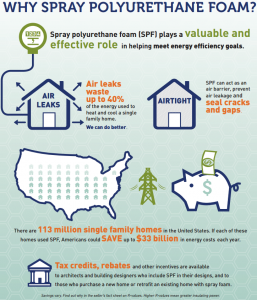 Spray polyurethane foam (SPF) offers a unique set of benefits that can help homeowners lower energy costs* and strengthen the home’s structure while achieving energy efficiency goals and reducing greenhouse gas emissions - and many future homebuilders recognize it!
Spray polyurethane foam (SPF) offers a unique set of benefits that can help homeowners lower energy costs* and strengthen the home’s structure while achieving energy efficiency goals and reducing greenhouse gas emissions - and many future homebuilders recognize it!
SPF was recently featured in a competition for graduate and undergraduate students, along with faculty advisers, to design a high-performance, energy-efficient home that can offset the majority - if not all - of its annual energy consumption. SPF’s versatility and effectiveness was showcased throughout the competition this year as four of the five grand winner finalists incorporated SPF in their designs to combat air leakage and prevent heat transfer.
The Department of Energy’s Race to Zero Student Design Competition hopes to inspire and develop the next generation of building science professionals through advancing building science curriculum in universities. The American Chemistry Council’s Spray Foam Coalition was a sponsor of this year’s Race to Zero Student Design Competition, which is based on a real-world scenario where competitors must update an existing home design into a high-performance design or develop a new high-performance home design for mainstream builders.
Justin Koscher, director of the Spray Foam Coalition, notes that spray polyurethane foam (SPF) is an excellent fit for net zero energy homes because it can help increase overall energy efficiency, provide cost savings on heating and cooling bills, and help decrease the level of greenhouse gas emissions entering our environment from traditional sources of energy.
Timothy Spencer and Zoe Kaufman, co-leads of the Three Rivers Design team from Carnegie Mellon University in Pittsburgh, Pennsylvania, and Ehsan Kamel, a member of Heritage Homes design team from Penn State University in State College, Pennsylvania, spoke about the benefits of SPF in their designs.
When deciding on the type of insulation material the team should use, Timothy and Zoe said their team decided on SPF as an air sealing material and Ehsan’s team chose two spray polyurethane foams as part of its insulation plan.
Ehsan said that SPF “would create an air-tight seal in any gaps or penetrations in building enclosure.” Ehsan continued, “After analyzing the durability, air tightness and R-Value of spray foam we realized that it is necessary to include both open and closed cell foams alongside other materials. Each provided benefits to optimize the insulation of the home while providing a balance between cost of materials and the energy efficiency of materials.”
When asked his thoughts on spray polyurethane foam Timothy said, “Air sealing is among the most cost effective ways to save energy. In our design, spray foam was key to sealing the home.”
When asked if the competition served as a learning experience in building energy efficient homes and buildings, all three participants answered the competition did provide such a learning experience. They said the competition allowed them to experiment with different forms of energy efficiency.
By the end of the competition, the Three Rivers House Design team and Heritage Homes design team had produced high-performance, energy efficient designs that would be able to be replicated using SPF.
Zoe added, “Tightening a building should be at the top of anyone’s list. It is the most cost-effective energy efficiency strategy and can be applied to both new and renovated buildings. Spray foam is an effective method for achieving this.”
*Savings vary. Find out why in the seller’s fact sheet on R-values. Higher R-values mean greater insulating power.





